Related Research Articles

A hybrid vehicle is one that uses two or more distinct types of power, such as submarines that use diesel when surfaced and batteries when submerged. Other means to store energy include pressurized fluid in hydraulic hybrids.
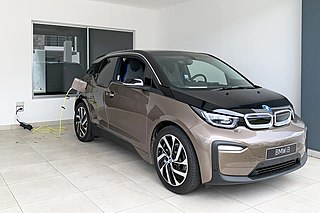
An electric vehicle (EV) is a vehicle that uses one or more electric motors for propulsion. The vehicle can be powered by a collector system, with electricity from extravehicular sources, or can be powered autonomously by a battery or by converting fuel to electricity using a generator or fuel cells. EVs include road and rail vehicles, electric boats and underwater vessels, electric aircraft and electric spacecraft.
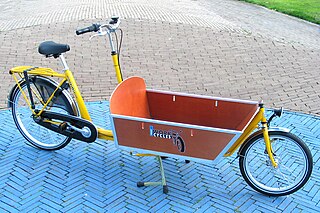
There have been many human powered vehicles designed and constructed specifically for transporting loads since their earliest appearance in the 20th century. They are referred to variously depending on the number of wheels — typically two, three, or four — and by their specific use. Adjectives used to describe the tasks to which the bicycles, dicycles, tricycles, or quadracycles are put include cargo cycles, freight cycles, box cycles, carrier cycles, and so on. Sometimes they are also called cycletrucks, which uses a sense of the word 'truck' predating the automobile.
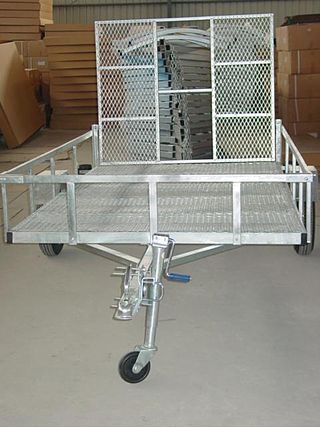
A trailer is an unpowered vehicle towed by a powered vehicle. It is commonly used for the transport of goods and materials.
Hybrid Synergy Drive (HSD), also known as Toyota Hybrid System II, is the brand name of Toyota Motor Corporation for the hybrid car drive train technology used in vehicles with the Toyota and Lexus marques. First introduced on the Prius, the technology is an option on several other Toyota and Lexus vehicles and has been adapted for the electric drive system of the hydrogen-powered Mirai, and for a plug-in hybrid version of the Prius. Previously, Toyota also licensed its HSD technology to Nissan for use in its Nissan Altima Hybrid. Its parts supplier Aisin offers similar hybrid transmissions to other car companies.
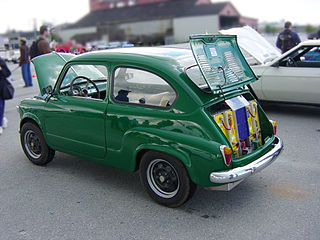
In automobile engineering, electric vehicle conversion is the replacement of a car's combustion engine and connected components with an electric motor and batteries, to create a battery electric vehicle (BEV).

A genset trailer is a range extending device for use with battery electric vehicles consisting of an internal combustion engine and an electric generator. They run on traditional fuels such as gasoline or diesel and are sized to provide the continuous power requirements for the vehicle they are used with. Most small to midsized passenger vehicles would require 15 to 20 kW for unlimited freeway travel using fuel. Larger vehicles could require 30 kW (40 hp) or more of power depending on how heavy or un-aerodynamic they happen to be. This essentially converts an electric vehicle into a series-hybrid.

A motorized bicycle is a bicycle with an attached motor or engine and transmission used either to power the vehicle unassisted, or to assist with pedalling. Since it sometimes retains both pedals and a discrete connected drive for rider-powered propulsion, the motorized bicycle is in technical terms a true bicycle, albeit a power-assisted one. Typically they are incapable of speeds above 52 km/h (32 mph), however in recent years larger motors have been built, allowing bikes to reach speeds of upwards of 72 km/h.
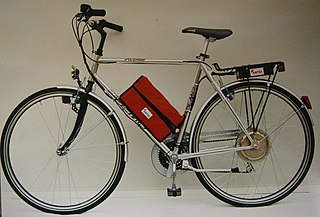
An electric bicycle is a motorized bicycle with an integrated electric motor used to assist propulsion. Many kinds of e-bikes are available worldwide, but they generally fall into two broad categories: bikes that assist the rider's pedal-power and bikes that add a throttle, integrating moped-style functionality. Both retain the ability to be pedaled by the rider and are therefore not electric motorcycles. E-bikes use rechargeable batteries and typically are motor-powered up to 25 to 32 km/h. High-powered varieties can often travel more than 45 km/h (28 mph).
This timeline of motorized bicycle history is a summary of the major events in the development and use of motorized bicycles and tricycles, which are defined as pedal cycles with motor assistance but which can be powered by pedals alone.
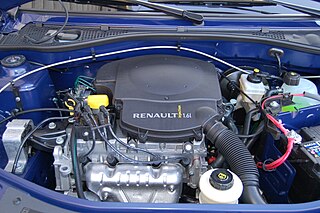
There are a wide variety of propulsion systems available or potentially available for automobiles and other vehicles. Options included internal combustion engines fueled by petrol, diesel, propane, or natural gas; hybrid vehicles, plug-in hybrids, fuel cell vehicles fueled by hydrogen and all electric cars. Fueled vehicles seem to have the advantage due to the limited range and high cost of batteries. Some options required construction of a network of fueling or charging stations. With no compelling advantage for any particular option, car makers pursued parallel development tracks using a variety of options. Reducing the weight of vehicles was one strategy being employed.
Mild hybrids (MHEV) are generally cars with an internal combustion engine (ICE) equipped with a minimally extended battery and an auxiliary electric combined motor and generator in a parallel hybrid configuration which is not enough for an electric-only mode of propulsion but does the engine to be stopped whenever the car is coasting, braking, or stopped, and then restarted once power is required again. Mild hybrids may employ regenerative braking and some level of power assist to the internal combustion engine.
Hybrid vehicle drivetrains transmit power to the driving wheels for hybrid vehicles. A hybrid vehicle has multiple forms of motive power.
The powertrain layout of a motorised vehicle such as a car is often defined by the location of the engine or motors and the drive wheels.

Electric motorcycles and scooters are plug-in electric vehicles with two or three wheels. Power is supplied by a rechargeable battery that drives one or more electric motors. Electric scooters are distinguished from motorcycles by having a step-through frame, instead of being straddled. Electric bicycles are similar vehicles, distinguished by retaining the ability to be propelled by the rider pedaling in addition to battery propulsion.
Motorcycle components and systems for a motorcycle are engineered, manufactured, and assembled in order to produce motorcycle models with the desired performance, aesthetics, and cost. The key components of modern motorcycles are presented below.
Hydraulic hybrid vehicles (HHVs) use a pressurized fluid power source, along with a conventional internal combustion engine (ICE), to achieve better fuel economy and reductions in harmful emissions. They capture and reuse 70–80% of the vehicle's kinetic braking/decelerating energy and potential descending energy compared to 55% for electric hybrids. For trucks and buses, this can also be less expensive than electric systems, due to the price of batteries required for the latter. Hydraulic hybrid vehicle systems can also weigh less than electric systems, due to the high weight of the batteries. This can lead to a lower impact on payload capacity, especially for heavy vehicle classes.

The Hyundai Blue-Will is a plug-in petrol-electric hybrid concept compact car designed by the South Korean car manufacturer Hyundai Motor Company. The vehicle was debuted at the 2009 Seoul Motor Show in South Korea.

A drivetrain or Transmission System, is the group of components that deliver mechanical power from the prime mover to the driven components. In automotive engineering, the drivetrain is the components of a motor vehicle that deliver power to the drive wheels. This excludes the engine or motor that generates the power. In marine applications, the drive shaft will drive a propeller, thruster, or waterjet rather than a drive axle, while the actual engine might be similar to an automotive engine. Other machinery, equipment and vehicles may also use a drivetrain to deliver power from the engine(s) to the driven components.

In automotive design, dual-motor, four-wheel-drive layout is mainly used by battery electric vehicles by placing electric motors on both front and rear axles and drives all four roadwheels, creating a four-wheel drive layout. This layout is made possible by the small size of electric motors compared to internal combustion engines, allowing it to be placed in multiple locations. It also eliminates the need of a drive shaft that are commonly used by conventional four-wheel drive vehicles to create space for batteries that are commonly mounted on the floor of electric vehicles.